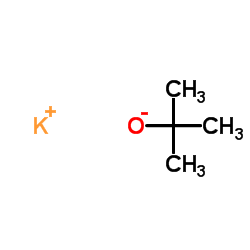potassium t-butoxide

potassium t-butoxide structure
|
Common Name | potassium t-butoxide | ||
|---|---|---|---|---|
| CAS Number | 865-47-4 | Molecular Weight | 112.21 | |
| Density | 0.910 g/mL at 20 °C | Boiling Point | 275°C | |
| Molecular Formula | C4H9KO | Melting Point | 256-258 °C (dec.)(lit.) | |
| MSDS | Chinese USA | Flash Point | 54 °F | |
| Symbol |


GHS02, GHS05 |
Signal Word | Danger | |
|
Silylation of C-H bonds in aromatic heterocycles by an Earth-abundant metal catalyst.
Nature 518(7537) , 80-4, (2015) Heteroaromatic compounds containing carbon-silicon (C-Si) bonds are of great interest in the fields of organic electronics and photonics, drug discovery, nuclear medicine and complex molecule synthesis, because these compounds have very useful physicochemical... |
|
|
Encapsulation of fish oil with N-stearoyl O-butylglyceryl chitosan using membrane and ultrasonic emulsification processes.
Carbohydr. Polym. 123 , 432-42, (2015) Fish oil-loaded microcapsules were prepared from oil-in-water emulsions using N-stearoyl O-butylglyceryl chitosan as shell material. The emulsions were prepared by both membrane and ultrasonic emulsification processes under variable conditions to examine the ... |
|
|
Utilizing capillary gas chromatography mass spectrometry to determine 4-benzotrifluoride t-butyl ether as a reaction by-product in fluoxetine synthesized using potassium t-butoxide as base.
J. Pharm. Biomed. Anal. 31(1) , 63-74, (2003) Fluoxetine hydrochloride has been prepared using two similar synthetic routes, both of which rely upon an ether formation reaction mediated by a base. The base used can affect the impurity profile of this reaction. It was proposed that the synthesis of fluoxe... |
|
|
Nanoparticles of alkylglyceryl-dextran-graft-poly(lactic acid) for drug delivery to the brain: Preparation and in vitro investigation.
Acta Biomater. 23 , 250-62, (2015) Poly(lactic acid), which has an inherent tendency to form colloidal systems of low polydispersity, and alkylglyceryl-modified dextran - a material designed to combine the non-immunogenic and stabilising properties of dextran with the demonstrated permeation e... |
|
|
First N-Heterocyclic Carbenes Relying on the Triazolone Structural Motif: Syntheses, Modifications and Reactivity.
Chemistry 21 , 15759-68, (2015) 4-Phenylsemicarbazide and 1,5-diphenylcarbazide are suitable starting materials for the syntheses of N-heterocyclic carbene (NHC) compounds with new backbone structures. In the first case, cyclisation and subsequent methylation leads to a cationic precursor w... |
|
|
Core-shell polymer nanoparticles for prevention of GSH drug detoxification and cisplatin delivery to breast cancer cells.
Nanoscale 7 , 17964-79, (2015) Platinum drug delivery against the detoxification of cytoplasmic thiols is urgently required for achieving efficacy in breast cancer treatment that is over expressed by glutathione (GSH, thiol-oligopeptide). GSH-resistant polymer-cisplatin core-shell nanopart... |
|
|
An ESIPT-based fluorescent probe for highly selective and ratiometric detection of mercury(II) in solution and in cells.
Analyst 140(8) , 2778-84, (2015) A novel ratiometric fluorescent Hg(2+) detecting system was rationally developed based on the typical excited state intramolecular proton transfer (ESIPT) characteristic of the latent fluorophore, 2-(1-(p-tolyl)-1H-phenanthro[9,10-d]imidazol-2-yl)phenol (Pol)... |
|
|
Synthesis of carbazoles via an intramolecular cyclization of 2-(6-substituted 3(Z)-hexen-1,5-diynyl)anilines and their related molecules.
J. Org. Chem. 69(6) , 2106-10, (2004) Various 2-(6-substituted 3(Z)-hexen-1,5-diynyl)anilines 1a-g were treated with potassium tert-butoxide or potassium 3-ethylpentanoxide in NMP at 60 degrees C for 2 h to give the corresponding 5-substituted carbazoles 2a-g in 36-65% yields together with indole... |
|
|
High yielding synthesis of N-ethyl dehydroamino acids.
Amino Acids 43(4) , 1643-52, (2012) Recently we reported the use of a sequence of alkylation and dehydration methodologies to obtain N-ethyl-α, β-dehydroamino acid derivatives. The application of this N-alkylation procedure to several methyl esters of β,β-dibromo and β-bromo, β-substituted dehy... |
|
|
3-Aryltetronic acids: efficient preparation and use as precursors for vulpinic acids.
J. Org. Chem. 74(3) , 1124-9, (2009) 3-Aryltetronic acids were prepared in one step by treatment of a mixture of methyl arylacetates and methyl hydroxyacetates with potassium tert-butoxide, via tandem transesterification/Dieckmann condensation. Several mushroom or lichen pigments, vulpinic acids... |